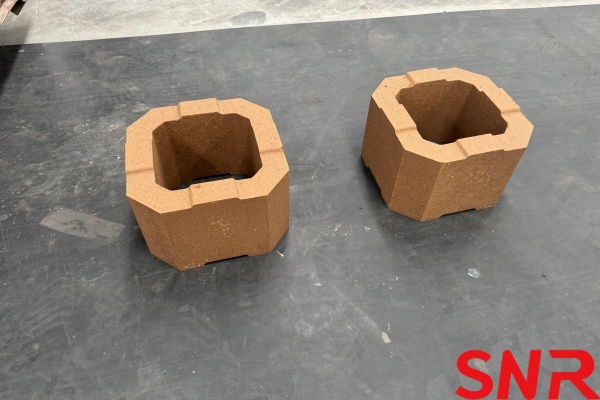The glass furnace is the core equipment for float glass production, and the regenerator, as the “lungs” of the glass furnace, bears the key functions of combustion air preheating and exhaust gas discharge. Blockages in the regenerator not only reduce glass furnace efficiency but also shorten its lifespan and increase production costs. This article explores the causes, impacts, and solutions for regenerator blockages, incorporating the latest technological advancements and real-world case studies.
I. Causes of Regenerator Blockages
I. Causes of Regenerator Blockages
Regenerator blockages are typically caused by the following factors:
1. Chemical Condensation
1.1 Reasons for Chemical Condensate Formation
Complex exhaust gas composition
Impurities in the fuel, such as sulfur, chlorine, and alkali metals (Na, K), generate compounds like SO₂, SO₃, HCl, Na₂O, and K₂O after combustion. These react with water vapor in the exhaust gas to form sulfates, chlorides, or low-melting-point eutectics (e.g., Na₂SO₄, K₂SO₄, NaCl).
For example:

►Temperature fluctuations leading to condensation
When the surface temperature of the regenerator‘s chimney bricks or ceramic bodies falls below the dew point of acidic gases, sulfuric acid, hydrochloric acid, or low-melting-point salts condense into liquid or solid deposits.
►Impurities in fuel or raw materials
Low-quality fuels (e.g., high-sulfur heavy oil, high-chlorine coal) or volatile impurities in raw materials (e.g., soda ash in glass batch) exacerbate condensate formation.
►Improper operating conditions
Excessive air coefficient (oxidizing atmosphere) promotes the conversion of SO₂ to SO₃, increasing sulfate formation. Prolonged reversal cycles can also lead to localized overcooling.
1.2 Specific conditions of blockage
1.2.1 Sediment type
►Sulfate/sulfite: White or yellowish-brown hard scale (such as CaSO₄, Na₂SO₄), adhered to the surface of the chimney brick.
►Chloride: Loose particles with strong hygroscopicity (such as NaCl, KCl), which may further corrode the refractory material.
►Silicate/eutectic mixture: Form glassy viscous substances at high temperature, blocking the pores.
1.2.2 Blockage location
►Exhaust gas inlet: Acidic gas condensation is prone to occur in areas with lower temperatures (such as the lower part of the regenerator).
►Chimney brick pores: Sediments gradually narrow the airflow channel, increase resistance, and in severe cases completely block it.
►Refractory gaps: Condensate penetrates into the brick joints, expands after cooling, and causes structural cracks (such as phase change expansion of sulfate).
1.2.3 Accompanying phenomena
►Increased pressure difference: Increased exhaust gas flow resistance and increased induced draft fan load.
►Decreased thermal efficiency: Reduced heat transfer capacity of the regenerator and insufficient preheated air temperature.
►Corrosion damage: Acidic condensate reacts with refractory materials (such as SiO₂ in silica bricks and alkali metals to form low-melting silicates), causing chimney bricks to pulverize and peel off.
1.3 Typical industry cases
Glass furnace regenerator: Due to long-term use of high-sulfur raw materials, a glass factory formed a sulfate crust about 2 mm thick on the surface of the chimney bricks, and the heat exchange efficiency decreased by 15%.
2. Flying material flashback
Blocking of the regenerator due to flying material flashback is a common fault in glass furnaces. Specifically, dust or unburned materials carried by high-temperature flue gas are deposited in the regenerator, causing the airflow channel to gradually block, thereby affecting the heat storage efficiency and even causing safety accidents. The following is an analysis of the specific situation:
2.1 Causes of flying material flashback
►Incomplete fuel combustion:
When the fuel (such as coal gas, heavy oil, etc.) is unevenly mixed with air or the oxygen content is insufficient, some unburned particles (flying materials) will enter the regenerator with the high-temperature flue gas.
►Dust carried by flue gas:
Raw materials in the glass furnace (such as glass batch materials, metal oxides, etc.) volatilize or break at high temperatures, forming fine particles that are carried away by flue gas.
►Improper operation:
Failure to switch the reversing valve in time, excessive fluctuations in glass furnace pressure, etc. may cause flue gas reflux (flashback), exacerbating the accumulation of flying materials in the regenerator.
2.2 Specific process of blockage
►Deposition stage:
After the flying materials (such as alkali metal salts, alumina, silicate, etc.) enter the regenerator with the flue gas, they condense due to the decrease in temperature and adhere to the surface of the regenerator (such as chimney bricks, ceramic balls).
►Chemical bonding:
Some flying materials (such as Na₂SO₄, KCl) melt at high temperature and react with the regenerator or dust to form dense scale.
►Accumulation blockage:
The sediment gradually thickens, blocking the chimney brick pores or the gaps in the regenerator, resulting in a decrease in the cross-sectional area of flue gas flow and an increase in resistance.
2.3 Hazards of blockage
►Decreased thermal efficiency:
The heat exchange capacity of the regenerator is reduced, the preheated air/gas temperature is insufficient, and fuel consumption is increased.
►Abnormal glass furnace pressure:
After the flue gas channel is blocked, the pressure in the glass furnace increases, which may cause flame splashing and equipment damage.
►Local overheating:
The airflow distribution in the blocked area is uneven, resulting in local high-temperature burning of the regenerator.
►Risk of shutdown:
In serious cases, the glass furnace needs to be shut down for cleaning, which affects production continuity.
2.4 Typical industry cases
Glass furnace: Soda ash (Na₂CO₃) in the batch reacts with SO₂ in the flue gas to generate Na₂SO₄, which adheres to the lattice bricks in the regenerator, forming "alkali lattice brick blockage".
3. Erosion of refractory materials
High temperature causes the load softening point (>1400℃) of the chimney brick to be exceeded, and the brick body deforms and collapses. Case data: The alkali metal vapor erosion rate can reach 0.5-1mm/year, especially in areas with frequent temperature fluctuations.
3.1 Main causes of refractory erosion
3.1.1 Chemical erosion
►Alkali metal vapor (Na₂O, K₂O):
After the soda ash (Na₂CO₃) in the batch of the glass furnace volatilizes, it reacts with the refractory material (such as silica brick, magnesium brick) to form low melting point compounds (such as sodium nepheline Na₂O·Al₂O₃·2SiO₂), causing the refractory material to pulverize or peel off.
Example: Silica brick (SiO₂) reacts with Na₂O to form a viscous glass phase, which forms a loose porous structure after erosion, which is easy to break and clog.
►Sulfate/chloride corrosion:
SO₂, SO₃ or chloride in flue gas react with Al₂O₃ and MgO in refractory materials to generate expansive salts (such as MgSO₄), causing material cracking.
►Acidic gases (SOx, NOx):
Corrode alkaline refractory materials (such as magnesia bricks) to generate magnesium sulfate or nitrates that are easy to fall off.
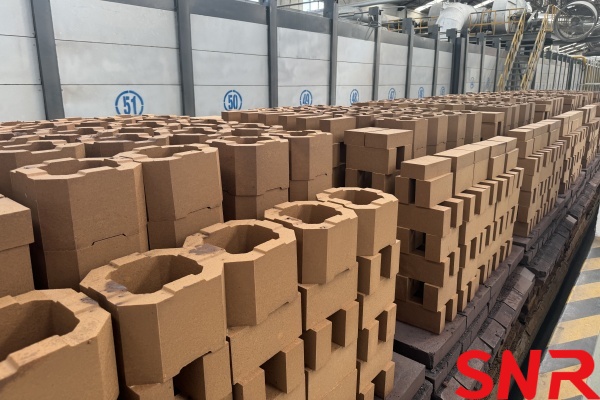
3.1.2 Thermal stress damage
►Temperature fluctuation: The periodic reversal of the regenerator causes rapid cooling and heating, cracks inside the refractory material, and eventually collapses into fragments.
►Local overheating: Uneven airflow distribution may cause overheating in some areas, softening or melting of the refractory material (such as chrome bricks forming low-melting-point FeCr₂O₄ in an oxidizing atmosphere).
3.1.3 Mechanical scouring and wear
Dust or unburned fuel particles continuously scour the surface of the refractory material, causing surface wear and fall off (such as the wear of coke powder in the regenerator of a coke oven).
3.2 Specific process of blockage
a) Initial stage of erosion: Chemical reactions or thermal shock cracks occur on the surface of the refractory material, generating a loose layer or microcracks.
b) Peeling stage: Erosion products or cracked debris fall off under the scouring of flue gas and enter the lower part of the regenerator or the chimney brick channel with the airflow.
c) Accumulation and blockage: debris mixed with flying materials and dust gradually accumulate in narrow passages (such as chimney brick corners and the bottom of the regenerator), obstructing airflow.
d) Secondary reaction intensification: blockages may further react with flue gas (such as moisture absorption and agglomeration, sintering and hardening), making cleaning more difficult.
3.3 Typical industry performance
Silica brick erosion: Na₂O erosion causes the surface of the chimney brick to "vitrify", which blocks the lower flue after peeling.
Magnesium brick erosion: SO₃ reacts with MgO to form MgSO₄, and the volume expansion causes the brick body to break.
Coke oven regenerator: coke powder reacts with refractory clay bricks to form a low-strength carbonized layer, which blocks the grid holes after peeling.
3.4 Hazards of blockage
a) Increased airflow resistance: After blockage, the glass furnace pressure increases, the fan power needs to be increased, and the energy consumption increases.
b) Decreased heat exchange efficiency: The effective area of the regenerator is reduced, and the air/gas preheating temperature is reduced.
c) Safety hazards: local blockage may cause flue gas to flow in a biased manner, causing local overheating or even explosion in the regenerator.
d) High maintenance costs: the glass furnace needs to be shut down to replace refractory materials, affecting production continuity.
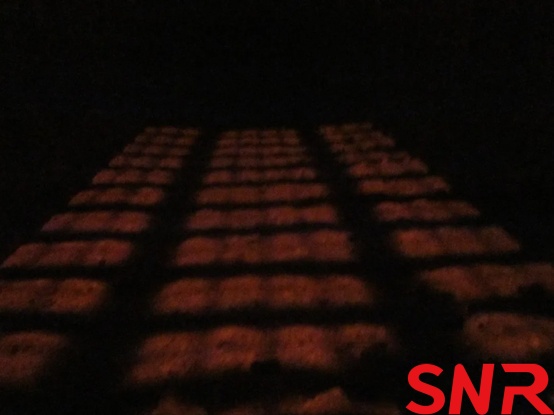
Regenerator projection
Blockage of the regenerator will trigger a series of chain reactions, directly affecting the operation and economic benefits of the glass furnace:
1. Energy consumption
Natural gas is not fully burned, and energy consumption increases by 5%-8%. Due to blockage problems, a certain factory increased its energy consumption by 1.2m³ natural gas per ton of glass.
2. Production capacity
The melting rate decreased by 3%-5%, and the production capacity loss was significant. When a glass furnace was severely blocked, the daily output decreased by about 10 tons.
3. Lifespan
Local high temperature accelerates the erosion of refractory materials and shortens the lifespan of the glass furnace. The lifespan of a certain factory‘s glass furnace was shortened from the expected 12years to 8 years.
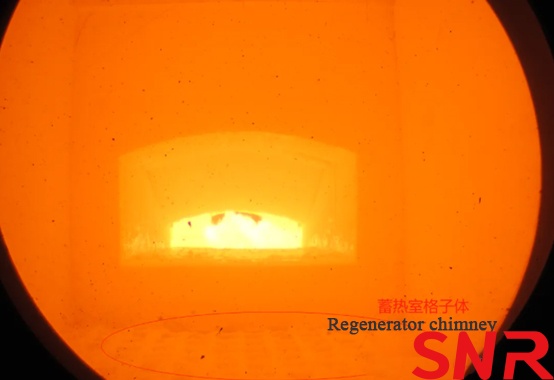
For the problem of regenerator blockage, the following are three common treatment methods and their advantages and disadvantages:
1. Mechanical dredging method: Use a poke rod to break the blockage.
Advantages: Simple operation and low cost.
Disadvantages: Low dredging rate (about 60%), great impact on the process.
Applicable to: grid holes with light blockage.
2. Bottom burning method: Heat the blockage to melt through a combustion gun.
Advantages: High dredging rate (>80%), significant effect.
Disadvantages: Professional construction is required, and environmental protection requirements are high.
Applicable to: Severe blockage and no collapse of bricks.
3. Chimney brick hot replacement: Replace the blocked chimney bricks when production is stopped.
Advantages: The restored function is close to that of a new glass furnace, and the life is extended.
Disadvantages: High cost (about 500,000 yuan/time), complex construction.
Applicable to: Blockage cannot be dredged or bricks collapse.
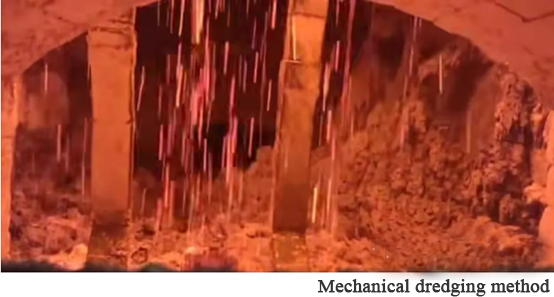
Case comparison
|
Method |
Construction time |
Cost |
Unclogging rate |
Impact on production
|
|
Mechanical unclogging |
3-5 days |
50,000 yuan |
60% |
Large fluctuation of glass furnace temperature |
|
Bottom firing method |
2 days |
100,000 yuan |
85% |
Stable glass furnace temperature |
|
Heat exchange |
2 days (modular) |
500,000 yuan |
95% |
Small downtime loss |
Prevention is better than cure! The following are key strategies for daily maintenance of the regenerator:
Intelligent Monitoring System
Deploy infrared thermal imaging and pressure sensors to monitor the temperature field of the checkered bricks and the flow status of the flue gas in real time.
Case
A plant detected potential blockage risks three months in advance through a sensor network, avoiding a maintenance cost of 1 million yuan.
Preventive maintenance plan
Purge the grid body quarterly and conduct a comprehensive endoscope inspection every year.
Data
Enterprises that strictly implement preventive maintenance have a 40% reduction in blockage incidence.
Raw material optimization
Reduce the use of high-sulfur clarifiers (such as sodium sulfate) and use low-volatility alternatives.
Case
A plant reduced the use of sodium sulfate by 30%, and the amount of ash accumulated in the regenerator decreased by 25%.
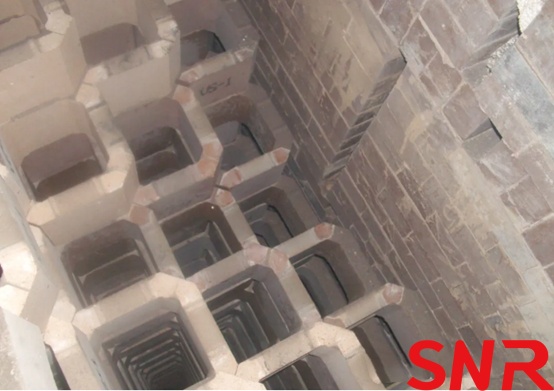
Based on market conditions, many existing glass furnaces will have some delayed ignition and production after construction is completed. This causes the inner walls, partitions and chimney of the regenerator, which are mainly made of magnesia-chrome bricks and magnesia sand bricks, to be easily affected by moisture, absorb moisture, and then hydrate and evolve into a decrease in strength, etc., which poses a safety hazard to the later ignition and production. Based on experience, two waterproofing solutions are proposed:
First: (electric heating)
⑴ Check the factory to prevent water leakage and prevent water from flowing into the glass furnace pit;
⑵ Drain the water in the basement and place 2-3 industrial fans in the damp places on both sides of the regenerator/pit to maintain air circulation and keep the environment dry;
⑶ The glass furnace and regenerator should be fully ventilated to keep the regenerator dry:
-Use the natural suction of the chimney to achieve the purpose of ventilation;
-Open the cover of the feeding port, open the "B" & "G" gates, and exchange the gates to the middle;
⑷ Heat the air at the bottom of the regenerator with electric heating to generate air flow, expel moisture, and keep the temperature inside the regenerator higher, so that external moisture is not easy to enter the regenerator.
⑸ Place a hygrometer or thermometer in the regenerator and the bottom of each port to monitor the humidity (temperature) situation, and measure the data to adjust the power of the electric heater.
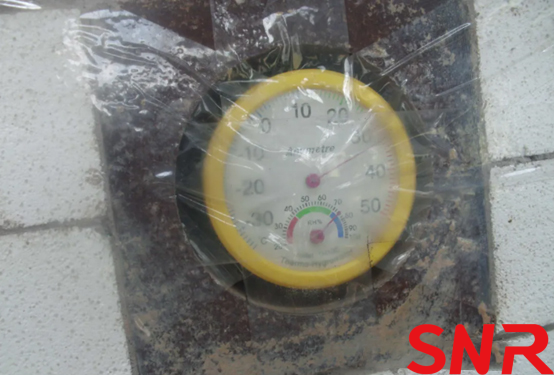
Second: (Coal-fired heating)
According to the specific conditions on site, a coal-fired glass furnace is designed to be built at the ash removal door of the regenerator. The hot air flow generated by it is used to heat the magnesium bricks in the regenerator to reduce the impact of moisture on the magnesium bricks and ensure their performance. The design adopts a bottom-up heating method. A coal-fired glass furnace is built at the ash removal door (ash cleaning hole) of each regenerator. The chimney effect is used to bring the hot air flow into the regenerator, thereby heating the interior of each regenerator and discharging the water vapor adsorbed on the brick body.
⑴ Sealing work of regenerator
→ The regulating dampers of each flue must be closed in place.
→ The fire viewing hole of the regenerator must be sealed with insulation cotton.
→ The burner brick hole must be sealed.
(2) Masonry
After the coal glass furnace is built, the size of the smoke inlet is about 250*250mm. The glass furnace body structure is dry-laid to facilitate later dismantling.
(3) Heating
→The temperature at the bottom of the regenerator is controlled at about 60~70℃, and the temperature at the top is controlled at about 30~40℃.
→The heating time is expected to be about 24 hours, and then sealed and insulated.
→After one heating, it can be maintained for 7-10 days, and then heated again according to the humidity and temperature inside the regenerator. Repeat the operation in sequence to keep the internal environment dry and prevent the hydration of magnesium bricks.
Nano coating technology
Coating a hydrophobic nano coating on the surface of the chimney bricks to reduce sulfate adhesion.
Advantages
The cleaning cycle is extended by 2-3 times, and the maintenance cost is reduced by 50%.
AI-assisted diagnosis
Combined with machine learning algorithms, the risk of blockage is predicted through historical data.
Case
A pilot project achieved an early warning of the blockage location one month in advance, and the maintenance cost was reduced by 30%.
The maintenance of the regenerator is the key to the long-term stable operation of glass production enterprises. Through scientific daily maintenance and advanced technical means, blockage problems can be effectively prevented, the life of the glass furnace can be extended, and production costs can be reduced. In the future, with the application of intelligence and new material technologies, regenerator maintenance will be more efficient and accurate.
Henan SNR Refractory Co., Ltd. is dedicated to the manufacturing research and development of fused cast AZS refractory materials and bonded refractory materials for the glass industry. Meanwhile, SNR can provide total solutions and services for glass furnace design, glass furnace construction, renovation, and upgrading. Please contact me if you have any requirements.


